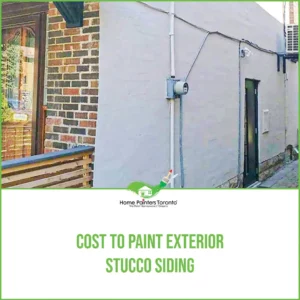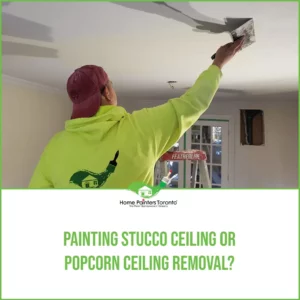
Stucco ceiling repair and painting is a service we get asked about a lot. Whether it is something obvious, like smoke or water damage, or simply fading from the sun, it’s important to keep your stucco ceiling in tip-top shape.
One of the great things about a stucco or popcorn ceiling is that it can hide surface dirt better than a flat ceiling. But, even though things may not be as noticeable, stucco ceilings still get dirty, sun-damaged, dingy and worn with age.
If you want to keep your stucco or popcorn ceiling looking great, follow our tips on stucco repair and painting.
Safety Measures During Stucco Ceiling Repair and Painting
Embarking on the journey of stucco ceiling repair and painting can be a rewarding endeavour that ultimately transforms the space you inhabit. It’s an opportunity to breathe new life into a room and increase your home’s value. However, just like any home improvement project, it’s crucial to prioritize safety and preparation to ensure the process is as smooth and hazard-free as possible. Let’s dive into the steps you should take to protect not only the physical space around you but also your health and well-being.
Covering Your Assets: The Importance of Prepping Your Space
Before you start the actual repair or painting, it’s essential to prepare your work area. This step is often overlooked in the excitement of getting the job done, but it’s paramount for protecting your furniture, flooring, and other belongings from damage or unwanted splatters.
- Clear the Area: Remove as much furniture and as many items as possible from the room. For items that are too heavy or bulky to move, consider pushing them to the center of the room.
- Use Drop Cloths: High-quality drop cloths are your best friends here. Opt for canvas or plastic sheeting to cover the floor and any furniture left in the room. Canvas is reusable and less slippery than plastic, offering better protection, while plastic is disposable and easier for quick clean-ups.
- Masking: Use painter’s tape to mask off any areas that you don’t want to get paint on, such as crown moldings, wall edges, and light fixtures. Masking these areas can not only save you time on clean-up but also ensure a crisp, professional-looking finish.
By taking the time to meticulously prepare your space, you protect your assets and create a safer, more efficient working environment.
Gear Up: The Essential Protective Equipment for Ceiling Repairs
Your safety should always be a top priority. Before you begin, make sure you are adequately equipped with the right gear to protect yourself from potential hazards.
- Eye Protection: Safety goggles or glasses are a must. When you’re looking up, plaster, paint, or debris can fall, posing a risk to your eyes.
- Respiratory Protection: Especially for sanding or if your home was built before the 1980s and might contain asbestos in the popcorn texture, wearing a mask or respirator is crucial. A basic dust mask can protect against particulate matter, but for finer particles or potential asbestos, opt for a respirator with a P100 filter.
- Cover Up: Sleeve shirts and pants can prevent irritation from plaster dust or paint splatter. Additionally, a hat or head covering can keep debris out of your hair.
- Ladder Safety: Ensure you have a stable ladder that gives you comfortable access to the ceiling. Never overreach or lean too far to one side; it’s safer to move the ladder frequently.
- Gloves: Wear gloves to protect your hands from sharp tools, chemicals, and skin irritants found in some repair materials and paints.
How To Keep Your Stucco or Popcorn Ceiling in Top Shape
Stucco ceilings, like any other surface, can experience water or smoke damage, fade due to sunlight, and get dirty, dingy and worn with age. Don’t neglect your ceiling. To keep your ceiling looking great, it’s important to make ceiling painting and repairs a part of your regular home maintenance.
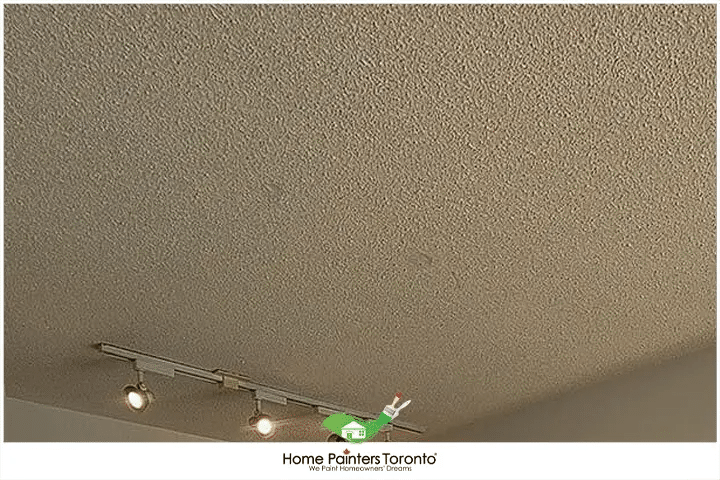
How Often Should You Paint or Repair Your Popcorn Ceiling?
In order to keep your ceiling in good shape, regular maintenance is key. So how often should you refresh your ceiling? Well, the thing with a popcorn ceiling is that it can hide dirt and grime well. Ceiling paint tends to last twice as long as wall paint. Many professionals believe a ceiling should be repainted approximately every 10 years.
But, if your ceiling falls into disrepair before then, it’s important to make the fixes as soon as you can.
Painting A Stucco Ceiling
A dirty ceiling in disrepair will call attention to itself, even if your ceiling wasn’t part of your style or design. That’s why it’s important to keep your ceiling clean and freshly painted. If you are looking to add style to your room, you can add a lot of character by painting your ceiling. There is a wide range of masonry paints on the market now, which means you have an extensive choice of colours. Painting your ceiling can also improve the air quality in your home by reducing the dust that is attracted to untreated stucco.
There are several steps involved in painting a stucco ceiling, which is why many homeowners leave the task to the professionals. From dusting and cleaning the ceiling to priming and painting, it’s a big job that can really weigh on your neck, shoulders and arm muscles. Consider hiring professionals, and you’ll rest easy!
Paint Your Ceiling White: White is a common paint colour for a popcorn ceiling. It is crisp and clean. So when it comes time to freshen up your ceiling, white can be a great way to go.
Consider a Colour: Ceilings with colour are making a comeback! Designers will regularly choose a contrasting or complementary colour for a ceiling to extend the space. If you are looking to add some style to your space, consider adding a colour to your ceiling.
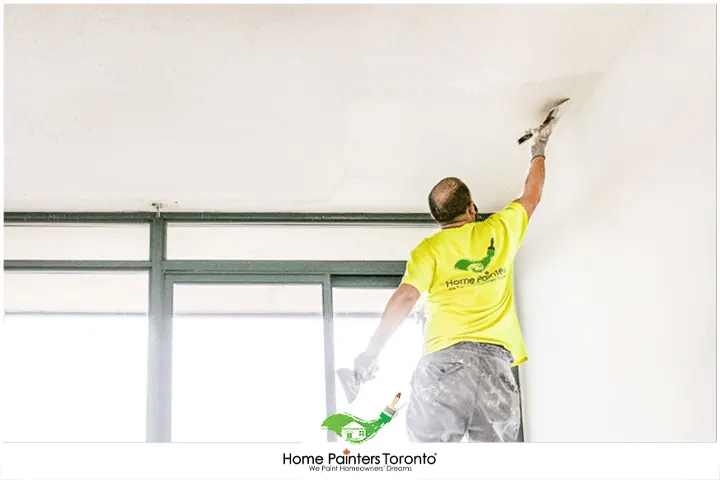
Repairing a Stucco Ceiling
Keeping your ceiling in good repair is crucial to the overall maintenance of your home. Here are some common stucco repairs we regularly see:
Repairing Cracks in a Stucco Ceiling: It’s important to repair cracks as soon as they’re noticed. First of all, a crack can be a natural breeding ground for mould. Also, repairing cracks can help strengthen your ceiling and extend the life of the existing stucco.
Repairing Water/Smoke Damage: Water and smoke damage can quickly turn an unobtrusive ceiling into an ugly mess. As soon as you notice the signs of water or smoke damage, it’s important to call in the professionals.
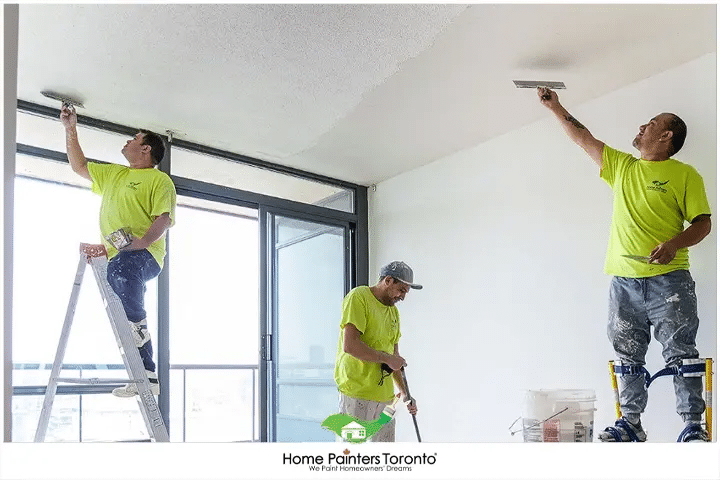
Professional vs DIY: Making The Leap
The journey of home improvement is a versatile one, open to both professionals and DIY enthusiasts alike. The process of transforming your stucco ceiling is a sublime way of stamping your unique identity onto your space. Now comes a crucial juncture on your home improvement journey: deciding between taking up the mantle or calling in the experts. Each route offers its own unique blend of challenges and rewards. Knowing when to wear the DIY hat and when to pass the bucket to professionals is an invaluable skill. Let’s explore it.
When to Call the Experts: Understanding Your Limitations
We all love a good DIY project, where we roll up our sleeves, get our hands dirty, and see our personal touch transform a space. But certain stucco ceiling repair and paint tasks require a professional touch. How do you know which ones?
- Dealing with Asbestos: If your house was constructed before the 1980s, your stucco ceiling might contain asbestos, which poses serious health risks, including lung cancer and mesothelioma. Asbestos abatement is highly regulated and needs competent professionals.
- Extensive Damage: Significant water damage, structural repairs, and excessive mould can be safely and thoroughly addressed only by professionals who have the training and equipment to handle such tasks.
- Time Constraints: Painting and repairing a stucco ceiling is time-consuming, especially when it’s your first time. If you’re on a tight schedule, hiring professionals will expedite the process.
Embracing your limitations can be an act of wisdom, not a setback. Experienced professionals can bring peace of mind that your stucco ceiling repair and paint project will meet your expectations and code requirements.
Is DIY Suitable for Your Project? Weighing the Pros and Cons
For many, the appeal of DIY is undeniable – the satisfaction of mastering a new skill, the joy of personal input, and often, cost savings. However, it’s worth weighing the pros and cons:
Pros:
Cost Savings: Doing it yourself can often be less expensive if the project is simple and you already have some necessary tools.
Learning Experience: Each DIY project is a learning opportunity, adding to your life skills.
Personal Satisfaction: There is an immense sense of accomplishment in seeing the fruits of your labour transform your space.
Cons:
Time-Consuming: DIY projects often take longer, especially if you’re learning as you go.
Risk of Mistakes: Without professional experience, it is easier to make errors, which could end up costing more to fix.
Potentially Messy: Without professional equipment, DIY projects can sometimes get messier.
Final Thoughts
Provided you’re in a position to devote the right amount of time and effort, DIY can be a fulfilling avenue to explore, enriching your experience and understanding of your home.
Above all, remember that the choice is yours and should reflect your comfort level, availability, and desired outcome. The goal of this journey is not just to repair and paint a stucco ceiling, but also to build an environment that resonates with peace and pride. Whether by your own hands or those of a professional, the real victory lies in creating a space that feels like home.
More Interesting Blogs Related to
“STUCCO CEILING REPAIR AND PAINTING”
Does your popcorn or stucco ceiling need a fresh coat of paint? Do you need to repair your ceiling? Call Home Painters Toronto for a free cost estimate. We are clean and efficient, and we make it easy for you to NOT DIY for this job. Call Home Painters Toronto for a free estimate on ceiling painting and repair. We’re happy to help! Call us at 416.494.9095 to learn more or email us at [email protected]. And don’t forget to follow us on all our social channels below!



